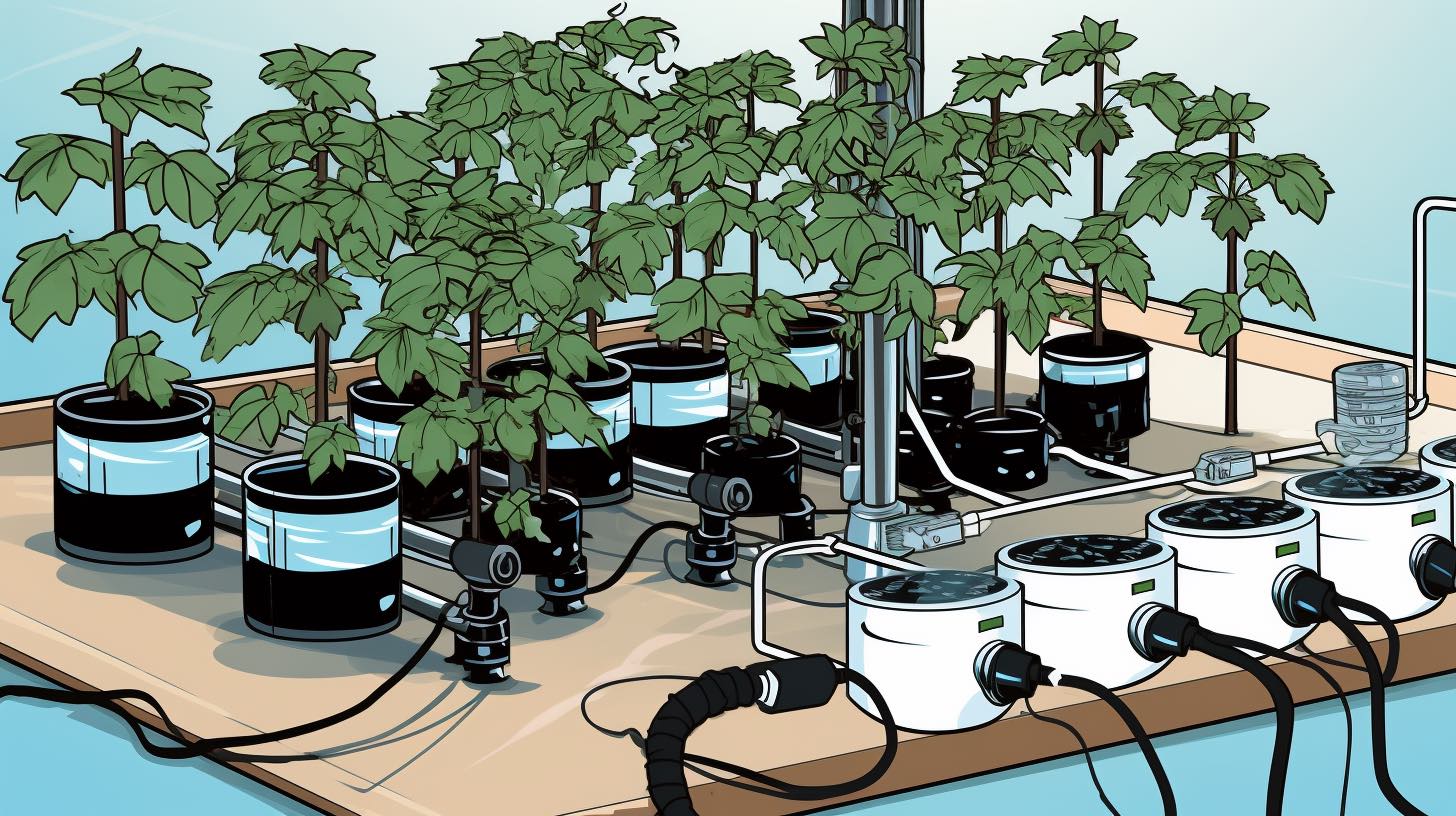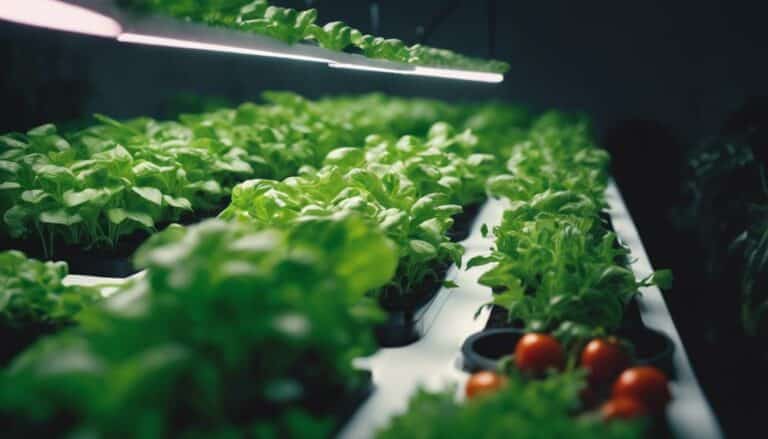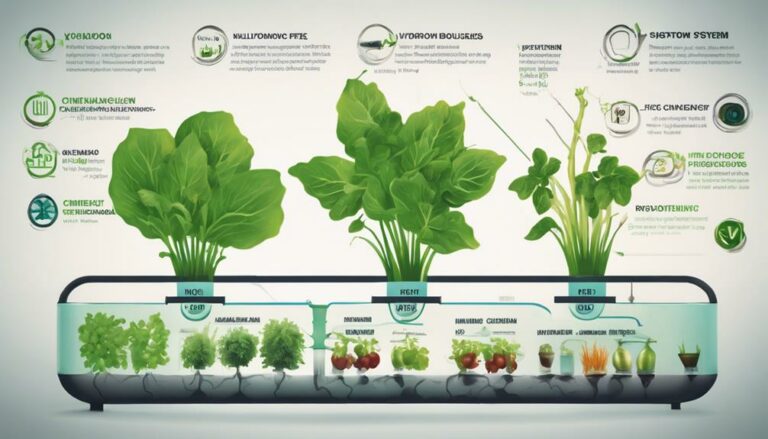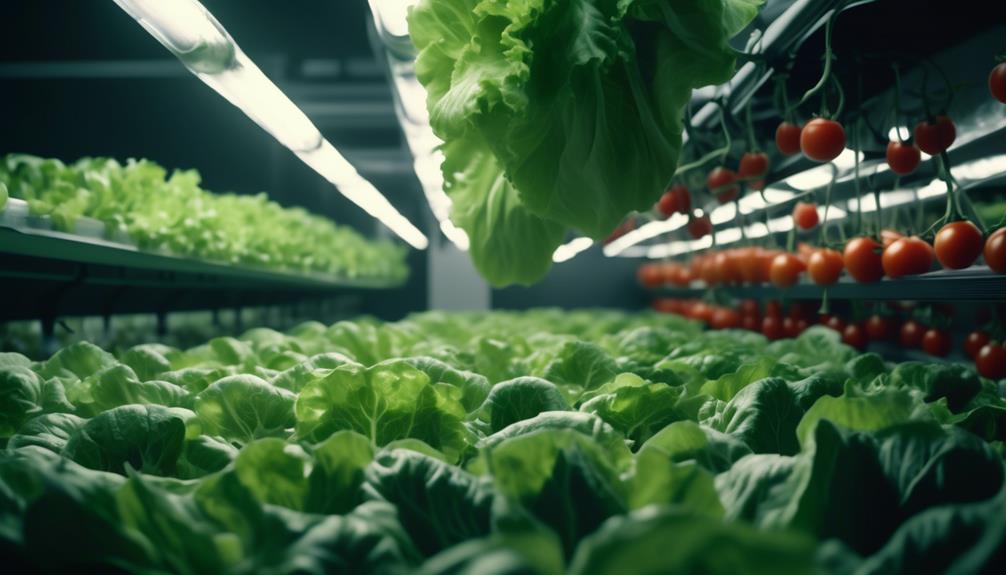I’ve got the ultimate guide to setting up a drip irrigation system for hydroponics. It’s a game-changer for those seeking innovation in their growing methods.
In this article, we’ll dive into the nitty-gritty details of choosing the right system, gathering the necessary materials, designing the layout, and connecting it to your hydroponic setup.
Get ready to revolutionize your growing process with this step-by-step guide on how to set up a drip irrigation system for hydroponics. Let’s get started!
Table of Contents
Key Takeaways
- Precise and efficient water delivery
- Improved plant growth and higher yields
- Minimizes the risk of diseases and pests
- Relatively simple maintenance
Choosing the Right Drip Irrigation System
I find it important to choose the right drip irrigation system for my hydroponics setup. A properly selected drip irrigation system offers numerous benefits for my plants.
Firstly, it provides precise and efficient water delivery, ensuring that each plant receives the right amount of water without wastage. This results in improved plant growth and higher yields.
Additionally, drip irrigation systems minimize the risk of diseases and pests, as the water is delivered directly to the plant roots, keeping the foliage dry.
Furthermore, maintenance of a drip irrigation system is relatively simple. Regularly checking the system for clogged emitters and cleaning them ensures smooth operation. Periodically flushing the lines with clean water also helps to prevent blockages.
Choosing a high-quality system and performing regular maintenance will ensure optimal performance and long-term success in my hydroponics setup.
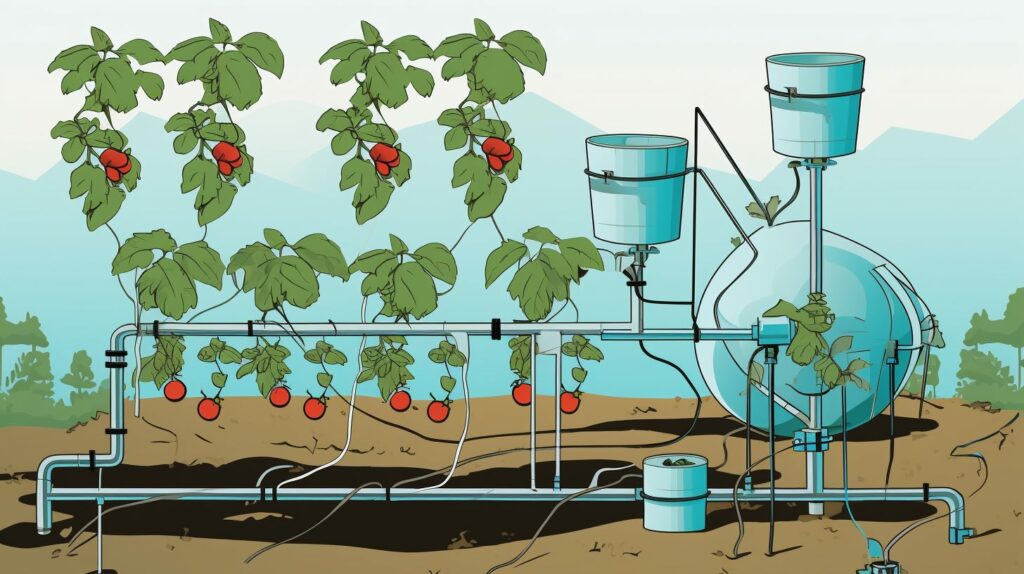
Gathering the Necessary Materials and Tools
To get started, I’ll need to gather all the materials and tools necessary for the drip irrigation system.
Here’s a step-by-step guide to help you understand the installation process:
Tools and Materials Needed
- Drip tubing: This is the main component that delivers water to the plants.
- Pressure regulator: It helps maintain a consistent water pressure.
- Filter: Prevents clogging by removing debris from the water.
- Emitters: These regulate the flow of water to individual plants.
- Connectors: Used to join the tubing and other components.
- Timer: Controls the irrigation schedule.
Installation Process:
- Measure and mark the garden area.
- Lay out the drip tubing according to your plant arrangement.
- Connect the tubing to the water source.
- Install the pressure regulator, filter, and timer.
- Attach the emitters to the tubing near each plant.
- Turn on the water and adjust the flow rate as needed.
Designing Your Drip Irrigation Layout
When designing your drip irrigation layout, there are a few key factors to consider.
It’s important to determine the optimal watering intervals for your plants, as well as the placement of the drip emitters.
Optimal Watering Intervals
The optimal watering intervals for a drip irrigation system in hydroponics depend on the specific needs of the plants. To determine the ideal watering frequency, it’s crucial to consider the soil moisture levels and adjust accordingly.
Here are three key factors to keep in mind:
- Plant Type: Different plants have varying water requirements. Some may prefer to be consistently moist, while others may thrive in drier conditions. Researching the specific needs of your plants is essential for setting the right watering intervals.
- Growth Stage: As plants progress through different growth stages, their water needs may change. For example, seedlings require more frequent watering to establish their roots, whereas mature plants may require less frequent watering to avoid oversaturation.
- Environmental Factors: Factors such as temperature, humidity, and light intensity can impact the rate at which plants absorb water. Monitoring these factors and adjusting watering intervals accordingly can help optimize plant growth and maximize water efficiency.
Placement of Drip Emitters
I carefully consider the placement of drip emitters to ensure optimal water distribution for my plants’ needs. Drip emitter spacing is crucial in achieving uniform watering and preventing over or under-watering.
To maintain water pressure and maximize efficiency, I strategically position the emitters based on the plant’s size, water requirements, and root spread. For smaller plants, like herbs or lettuce, a spacing of 6-12 inches between emitters is ideal. Larger plants, such as tomatoes or peppers, may require a spacing of 12-24 inches.
It’s important to note that emitter spacing should be adjusted as the plants grow to accommodate their increasing water needs.
Installing the Main Water Supply Line
To install the main water supply line for my hydroponic drip irrigation system, I’ll need to connect it to the water source and ensure a secure connection. This step is crucial to maintain optimal water pressure and ensure the efficient operation of the system.
Here are three important considerations when installing the main water supply line:
- Water Pressure: It’s essential to check the water pressure of the source before connecting the supply line. The ideal water pressure for a hydroponic drip irrigation system is between 20-40 psi. If the pressure exceeds this range, a pressure regulator should be installed to prevent damage to the system.
- Filtration System: Installing a high-quality filtration system is necessary to remove any impurities and debris from the water supply. This ensures that the drippers and emitters remain unclogged, preventing blockages and maintaining the system’s efficiency.
- Secure Connection: To ensure a secure connection, use fittings and connectors that are specifically designed for drip irrigation systems. These fittings should be tight and leak-free, preventing any water wastage and ensuring a consistent water supply to the plants.
Setting up the Drip Emitters and Distribution Lines
When placing the drip emitters and distribution lines, I ensure they’re positioned accurately for optimal water distribution and plant coverage. The placement of drip emitters is crucial in ensuring that each plant receives an adequate amount of water. I make sure to space the emitters evenly along the distribution lines, taking into account the specific water requirements of each plant. This allows for efficient watering that minimizes water waste and ensures that all plants receive the necessary amount of moisture.
Additionally, I carefully consider the watering intervals when setting up the drip irrigation system. This involves determining the frequency and duration of watering based on factors such as plant type, growth stage, and environmental conditions. By properly placing the drip emitters and adjusting the watering intervals, I can create an innovative and efficient irrigation system for optimal plant growth and productivity.
Connecting the Irrigation System to the Hydroponic Setup
To connect the irrigation system to the hydroponic setup, I’ll need a few necessary equipment and tools, such as a hose and connectors.
The first step is to ensure a proper hose connection by securely attaching the hose to the water source and the hydroponic system.
Once the connection is established, I’ll then proceed to set up the water flow, adjusting the water pressure and flow rate to ensure optimal irrigation for the hydroponic plants.
Necessary Equipment and Tools
I’ll need a water pump, drip lines, emitters, and a timer to set up the drip irrigation system for my hydroponics. The drip irrigation system offers several benefits for hydroponic gardening. It ensures efficient water usage by delivering water directly to the roots, reducing water wastage and evaporation. Additionally, it allows for precise control over the amount of water and nutrients each plant receives, promoting optimum growth.
To ensure the longevity and effectiveness of your drip irrigation system, here are some maintenance tips:
- Regularly check and clean the emitters to prevent clogging, which can hinder water flow and affect plant health.
- Inspect the drip lines for any leaks or damage and promptly repair or replace them to avoid water loss and ensure proper irrigation.
- Clean and maintain the water pump regularly to prevent blockages and ensure smooth operation.
Proper Hose Connection
Connecting the hose properly ensures a secure and efficient flow of water to my hydroponic garden. Hose maintenance is essential for ensuring the longevity and reliability of the irrigation system.
Regularly inspecting the hose for any signs of wear and tear, such as cracks or leaks, is crucial. If a leak is detected, troubleshooting becomes necessary.
First, I’d check the connections for any loose fittings and tighten them if needed. If the leak persists, I’d examine the hose itself for any punctures or splits. Small leaks can often be repaired with a patch or sealant designed for garden hoses. In more severe cases, it may be necessary to replace the damaged section of the hose.
Setting up Water Flow
Once the hose is properly connected, water flows smoothly through the irrigation system. To ensure optimal water flow, it’s crucial to consider the water pressure.
Here are some troubleshooting tips to help you set up the water flow effectively:
- Check the water pressure: Use a pressure gauge to measure the water pressure in your system. The ideal range for most drip irrigation systems is between 20 and 40 PSI (pounds per square inch).
- Adjust the pressure regulator: If the pressure is too high, use a pressure regulator to reduce it. This will prevent damage to the system and ensure even water distribution.
- Clean the filters: Clogged filters can restrict water flow. Regularly inspect and clean the filters to remove any debris or sediment that may accumulate.
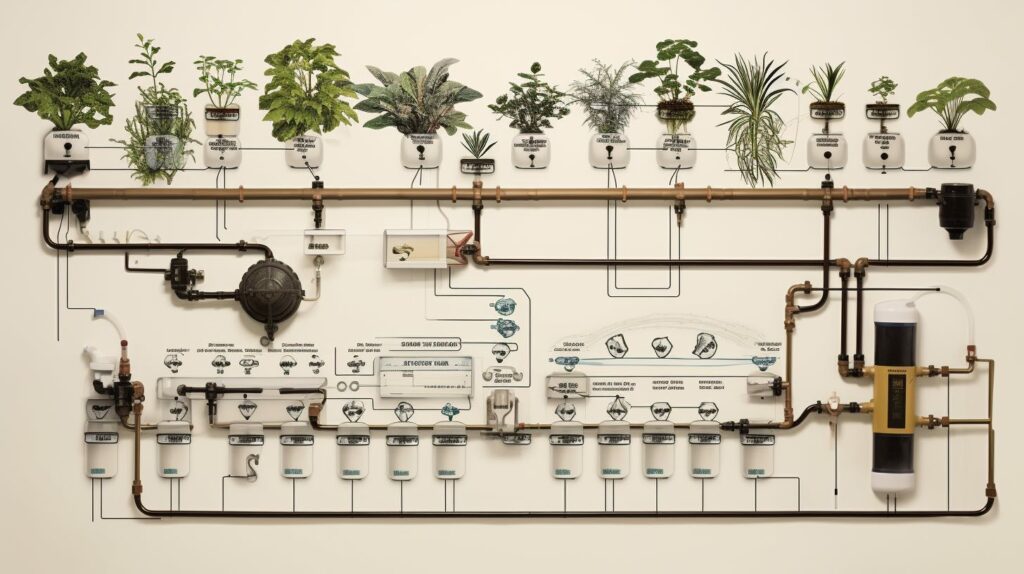
Testing and Adjusting Your Drip Irrigation System
To ensure optimal performance, I’m constantly monitoring and fine-tuning my drip irrigation system for my hydroponics setup. Testing methods are crucial for maintaining the efficiency of the system.
One effective testing method is the bucket test. Simply place a bucket under the drippers for a set duration and measure the amount of water collected. This will help determine if the flow rate is appropriate.
Another important step is troubleshooting. If you notice uneven water distribution, check for clogs in the drippers or tubing. Clear any obstructions to ensure proper flow. Additionally, check for leaks and ensure all connections are secure.
Regularly inspecting and adjusting the system will help prevent problems and ensure consistent and efficient watering for your hydroponics plants.
Frequently Asked Questions
Conclusion
In conclusion, setting up a drip irrigation system for hydroponics requires careful planning, the right materials and tools, and proper installation.
By choosing the right system, designing an effective layout, and connecting it to your hydroponic setup, you can ensure efficient water distribution and optimal plant growth.
It’s important to test and adjust your system as needed to maintain proper water flow and prevent any issues.
Follow these steps to successfully implement a drip irrigation system for your hydroponic garden.

